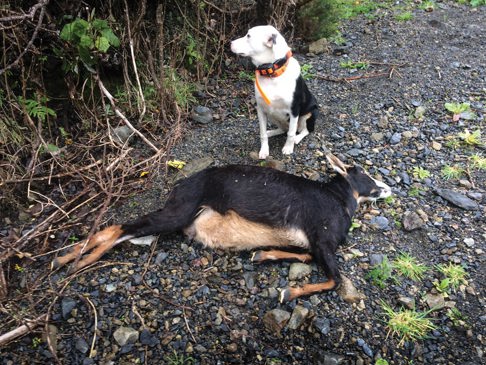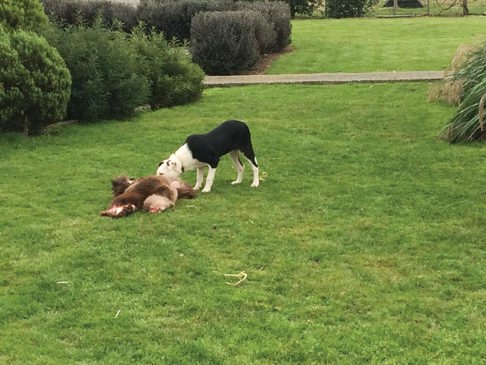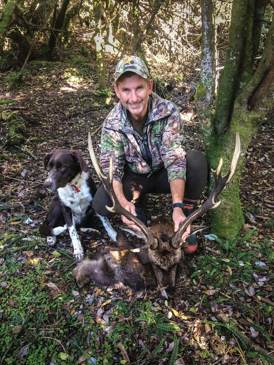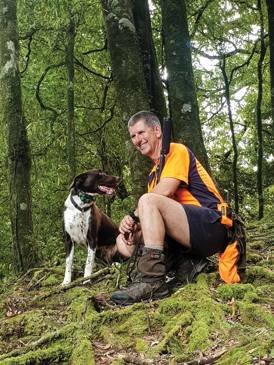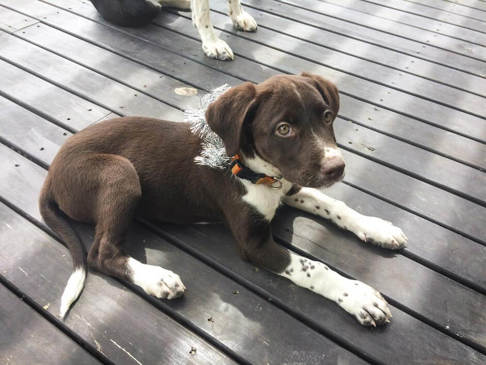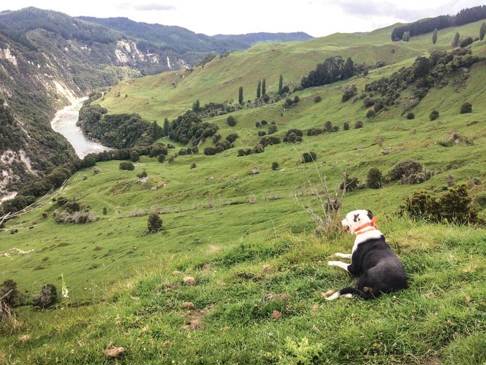In December last year I made the tough call to give my two loyal and highly capable pig dogs to a good mate.
With business and family commitments requiring a lot of my time these days, I made the decision after more than a little soul searching. A lot of it was about what was good for the dogs. I owed them that much.
And just like that, I had no pig dogs. Problem was, I loved having a dog with me and I still loved my hunting. I turned 50 last year and I realised there was still a large chunk of big country that I wanted to look into (isn’t there always?) and limited time meant much of it had been spent crawling around in gorse gullies after pigs. I have really migrated back to bush hunting in recent years too, for what in many ways is the ultimate hunting challenge. Where technology doesn’t make a blind bit of difference and it is all down to the hunter. So, what to do?
Twenty or more years ago, before I took up pig hunting, I had a ball shooting a lot of deer over an indicator dog. We were a tight little team. I have always loved the bond you can have with just one dog when you are working closely together.
A well-trained dog fits in with family life. It’s become a bit of a fashion trend to own a dog these days and there is so much information available on training and running indicator dogs that a beginner may be overwhelmed by all the opinions out there. What I will talk about are the things that you can do to make life easier for you and your dog. Kind of like a basic training kit for the everyday person.
Some of my good friends are full-time professional hunters, whose key tool is an indicating dog. They have forgotten more than I will ever learn, however even we mere mortals can get it pretty right if we apply the basic fundamentals. I wrote about indicator dogs some time back and got a good response from that. Fact is though, you never stop learning and there are things I used to do 20 (or even just five) years ago that I now find myself no longer doing. Given the amount of current interest, I thought you might like to take a walk with me through what I have been doing recently and hopefully there might be something useful in there for you.
When I decided that I wanted to dip my toe back in the ‘indicating’ water, the first question was ‘which dog?’ I have always liked heading dogs so I decided on one with plenty of eye, which is essentially another type of ‘point’. Breeds aside, it comes down to ‘desire to hunt’, and brains and temperament in particular. You must have those two ingredients no matter what dog you run. You can get lucky with some random mutt, but if you want to hedge your bets, then look at the breed traits (good and bad) and the parents, grandparents and previous litters. To quote a dog trialist “It’s hard enough to get a good pup out of good parents”. Spot on!
A local farmer had bred a litter from a very good line of heading dogs. I knew the impressive whakapapa going back three generations from further north. A wee bitch caught my eye as she was calmer than the others and obviously very smart. I love pups and training them, but I made myself go back and check her at different times when she was in different play/sleep stages. She still looked good. I picked her up and called her Belle.
Belle was a cracking wee pup with a heap of brains and an obvious hunt drive as per her breed. I started with the basics and she was very easy to train. The only slight issue was her exuberance but I lost no sleep over that as she would calm down with age and maturity.
It was obvious that she came from a line of dogs with a ton of work drive, who were conditioned to being under command, if that makes sense.
The training went well, and I will talk more on how I do that later but what I want to tell you now is that I hit a bump in the road with Belle. She was gun shy. I have trained any number of dogs and never had an issue before as I am very careful with this part of the training, but Belle didn’t gel with that. I won’t go into detail here with what I do except to say I put in a ton of prep time and had her rock solid around banging and loud noises and she was fine. Stage one was ticked off with no issues.
On the day I introduced the gun, I had her playing in the yard with my wife and her wee dog behind a line of flaxes, while I sneaked up the paddock 100m away with a suppressed 22. Belle was playing away and totally preoccupied and Liz radioed me that all was well. I faced the other way and fired a subby. The change in Belle was instant – she was very much on the back foot. I had never experienced this level of sensitivity with another dog. I stopped right there and went back to square one.
Over a significant amount of time and effort, she slowly came along and was OK with a cap gun and suppressed 22 shots. Given that she was under good command by that stage and with her obvious desire to work, I made the call to do some carefully managed hunting with a suppressed 22 to see if she would join the dots and associate the firearm with some fun. So, we went hunting and shot some goats. Belle tracked well and was doing fine with the wee 22.
Then one unlucky day up north, we got stuck in the middle of an electrical storm while we were out. The first thunder clap made Belle gap it from me and disappear. She totally ignored the ‘stop’ whistle, whereas previously she was rock solid. Bugger! Thankfully I had the tracking collar on her, and I could see that she was back tracking all the way to the hut.
When I finally got back an hour or two later, she was waiting at the ute for me, seemingly none the worse for wear. It was clear though that she was highly sensitive to this sort of sound. A good friend of mine who knows his stuff took her for a period of time and he ran her with his dogs. He managed to get her pretty good with them and up to a suppressed 223.
When she came back to me and was on her own, she was on the back foot again. The problem was mine to own, not Belle’s, and there may well have been something I did that caused it. I would have spent roughly ten times the usual amount of time building her up, but to no avail.
In speaking to farming friends who have run a lot of heading dogs, I learnt that the stronger the eye, the bigger the issues. Their other comment was that there are always a number of heading dogs that you cannot use a stock whip around. Period. Belle had the makings of a top dog and the only way I could see her getting beyond the gun issue was to be used in a bailing situation first where there was already plenty of noise and action happening.
I did not need or want a bailer so I made the hard call to move her on to someone who did. At 18 months old, she went to a young guy as a professional goat dog and is going very well. She started being used on the bail in controlled situations and gradually acclimatised again to suppressed shots while she was totally absorbed in the action and noise. She has made the grade and the call I made was the best for her and for me.
Lesson number one: if you want a dog for a specific purpose, not all of them will make the grade, even when you do all you can.
It was back to the drawing board for me – what should I do now? The answer was to go again, but with what? I noticed some pups for sale down south from the second litter of a particular cross. The mother was a Springer spaniel over a Wirehaired pointer while the father was a placid heading dog used on a deer unit. Both had great temperaments and the previous litter was shaping up well. I interviewed the breeder and also people who had previous litter mates. I was looking for a biddable pup with brains and the cross sounded good.
I made the call. Let’s be frank – I took a risk getting a crossbreed as you never really know which breed will be dominant and every pup in a litter can vary one way or the other. I looked very carefully though at the breed mix, the parents and the previous litter. This is the single biggest area where I see people make mistakes. They don’t look hard enough at what they want or take enough time to find the right breed and pup within that breed. It is so hard to tell fully in a seven-week old pup, so the whakapapa is the most certain way. You should never follow trends or emotion.
Do your research with proven people. And remember that many breeders with pups to get rid of want you to take one. I like heading dogs and I have to admit to a huge soft spot for good spaniels. They are some of the most biddable little dogs ever and most crosses with spaniel in them are really nice-natured dogs. I would have got a purebred field spaniel but felt that was in conflict with what I wanted (sneak and point). A quarter cross was perfect.
Sami (Sam) arrived in due course and fitted in straight away. She was an interesting mix of cruisy, biddable and robust. She immediately made it obvious that she was a lot different to Belle – a good deal less sensitive and highly strung. I realised this when I was using the drop saw in the workshop one day and Sami came to look for me and fell asleep against my leg while I was working on the saw. She is now 18 months old and progressing very nicely. Let’s take a walk through her training and what she does.
What does a recce hunter need his/her dog for? This is the first thing you need to consider. I would suggest your needs will fit somewhere in between company on the hill and a canine ungulate-seeking machine that takes you to every cloven-hooved animal sucking air within your block. Let’s be frank, that is everyone’s dream, but most rec hunters end up settling for the first option, with the odd bit of winding and finding thrown in. That’s OK too. I want to take a step back from that.
Before getting a dog that finds you deer, you must first make sure you do not run a dog that loses you deer. And you must be able to find deer without a dog.
The biggest challenge that I see people struggle with in their indicating dog is steadiness. A dog that is rash, pushy, whiney and/or uncontrolled will only wind you up and you certainly won’t enjoy your hunting half as much. In my opinion, half of this issue can be solved through good breeding (calm-natured dogs) and the other half through training. Pick your pup VERY carefully. Do your research.
So, what did I want Sami to do? Well I do a mix of recce and professional hunting and so I need her to be pretty smart on the hill. Basically, she must find animals in the bush that I would have missed and then take me to them, calmly and carefully. Sami also had to fit in to family life and be my buddy. There is no conflict here if you do your mahi.
How does that look in the real world? Well, before training your pup, you must train your family members. Now that sounds bad, but it really isn’t a big deal. My friends and family know that I am very particular about what is done around Sami to ensure that she is not receiving mixed messages. They laugh at me but they do try to help out. That is all it takes. There is no harm if there is a family gathering where there may be issues in removing the dog from the situation to ensure it is not compromised. You have a dog – a kennel is OK – your dog doesn’t need to sleep on the bed or be at the table for Christmas. These are called ‘boundaries’. As the dog gets older and finds its place in the world and understands its role, this gets easier. In time, extra distraction can serve as a useful training opportunity.
So I had Sami at home and growing up in an environment that was geared towards helping her to be successful. What did I do to train her towards her future role? We will cover that in the next issue. Till next time.
Cheers, Johnny
